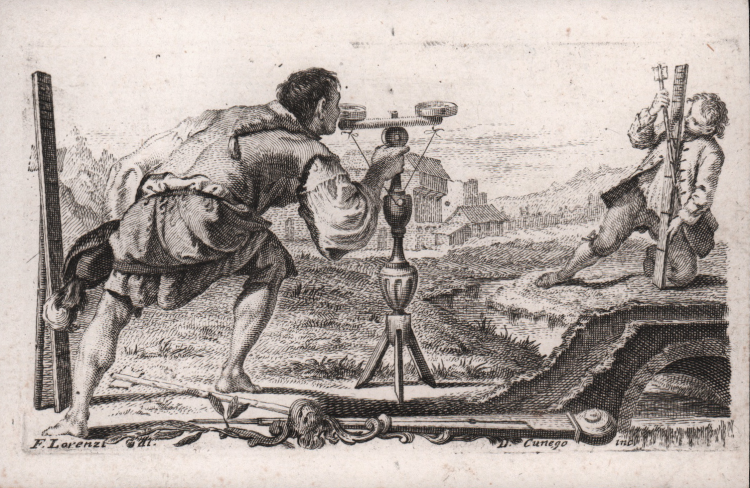



| Reference: | S45170 |
| Author | Domenico CUNEGO |
| Year: | 1758 ca. |
| Measures: | 120 x 70 mm |


| Reference: | S45170 |
| Author | Domenico CUNEGO |
| Year: | 1758 ca. |
| Measures: | 120 x 70 mm |
Etching, ca. 1758, signed in plate at lower right.
From a subject by painter Francesco Lorenzi (1723-1787)
The theodolite is an optical telescope instrument for measuring azimuthal (i.e., contained in a horizontal plane) and zenithal (i.e., contained in a vertical plane) angles, used for geodetic and topographical surveys. It was invented in the 16th century, refined over time in its optical-mechanical components. Theodolites were key tools in the production of topographic maps and were also used in construction projects.
The engraving is one of vignettes, outlined by Francesco Lorenzi and engraved by Domenico Cunego, prepared for Giambattista Spolverini's book La coltivazione del riso, printed in Verona by Agostino Carattoni in 1758.
Beautiful proof, with thin margins, in very good condition.
Domenico CUNEGO (Verona, 1724 o 1725 – Roma, 8 gennaio 1803)
|
Cunego was born in Verona. Having studied under the otherwise-unknown painter Francesco Ferrari, he began his artistic career as a painter, producing several works, all of which are now lost or untraceable. At age 18, however, he switched to engraving (a field in which he was possibly self-taught). He died in Rome.
The engravings he made depicting Michelangelo's Sistine Chapel ceiling, published in Gavin Hamilton's Schola Italica Picturae (1773), were an important source for the artists of his time. He is notable not only for reproducing paintings by his famous fellow-countrymen like Guido Reni and Italian contemporaries such as Antonio Balestra, Francesco Solimena, and Felice Boscaratti, but also works by British artists in Italy catering to Grand Tourists. The latter included Gavin Hamilton's cycle of 6 works on the Iliad and David Allan's Origin of Portraiture.
His sons Luigi (b. 1750, d. 1823) and Giuseppe (b. 1760) were also engravers.
|
Domenico CUNEGO (Verona, 1724 o 1725 – Roma, 8 gennaio 1803)
|
Cunego was born in Verona. Having studied under the otherwise-unknown painter Francesco Ferrari, he began his artistic career as a painter, producing several works, all of which are now lost or untraceable. At age 18, however, he switched to engraving (a field in which he was possibly self-taught). He died in Rome.
The engravings he made depicting Michelangelo's Sistine Chapel ceiling, published in Gavin Hamilton's Schola Italica Picturae (1773), were an important source for the artists of his time. He is notable not only for reproducing paintings by his famous fellow-countrymen like Guido Reni and Italian contemporaries such as Antonio Balestra, Francesco Solimena, and Felice Boscaratti, but also works by British artists in Italy catering to Grand Tourists. The latter included Gavin Hamilton's cycle of 6 works on the Iliad and David Allan's Origin of Portraiture.
His sons Luigi (b. 1750, d. 1823) and Giuseppe (b. 1760) were also engravers.
|